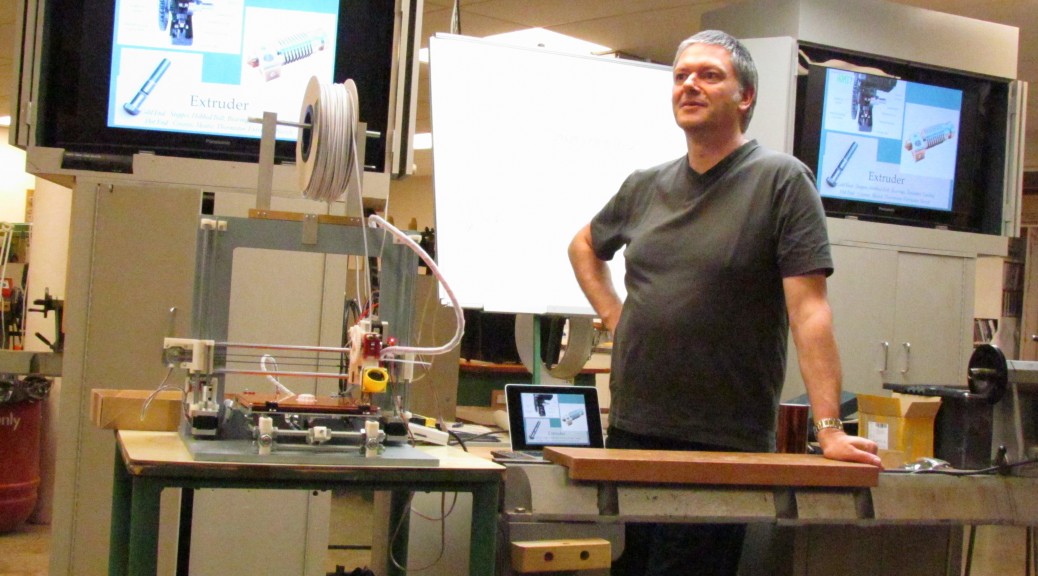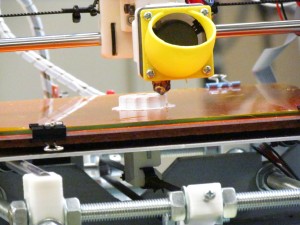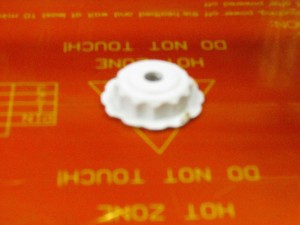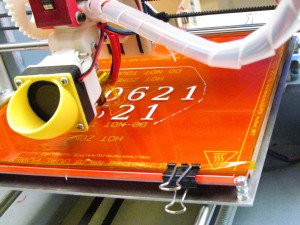Club Meeting: 21 October 2015
Report by: Graeme Mackay
Great Scott, it’s back to the future day, Ian is leading us on a long technical path from the home origins of 3D printing through to the current future. Ian feels he is in the midpoint of a long journey started in the mid-1990s. 3D printing is an exciting IT and technical movement. Although much is held under various patents, there is still a future going forward for this medium as many of the patents are expiring.
There are many small 3D printing units available on the general retail market. Companies such as Noel Leeming offering a $2000 unit in recent times. Ian looked at the course and said “I am going to do this myself”. He went to the net, that is the Internet, and started getting the bits to put together to make a 3-D printer. Ian used his CNC software skills to get going and joined it up with his vast knowledge of 3D CAD. A skill that started developing back in the mid-1990s and has been able to be kept on through due diligence, full application and perseverance of Woodturner.
The printing technologies have been here for a while and in various forms; extrusion printing, sintering printing and liquid polymer at the high end. So Ian headed out into the ionosphere of the blog set, open source joydem and special blogs (reprap.org). Ian provided views of the earlier iterations of this printer. The one on display (see photo) fits into space 400mm x 400 mm x 250 mm. He made the observation that the smaller size printers are related to the size of the domestic doorway i.e. that is the amount that you can sneak through quickly before anyone sees aborted under the home.
The next but it is a demonstration walk the audience through the requirements and choices;
- deciding on the plastic type (in his case ABS)
- the need for the printer to have its own computer operation and drive
- the ability to drive from high end ST cards
- the drive for the vertical axis
- the drive is required for the X and Y axis
- the choices stepper motor
- the heated pad system for the base
- the software choices (and they were many)
Many the parts for operation were sourced from China and Taiwan with a nuts and bolts and framing coming from New Zealand the software choices were many and varied. Ian stated that it was to do was ones background skills ability and the whatever. This later to whatever covered CAD, slicing software, computer interface software is or printer firmware.
There were many trials and tribulations (although he did not mention many of the letter and detail). One of the challenges is getting to learn how to bond the layers and developed support structures to assist the printing. Examples of the printing support structures were available for view in all their complexity and provided an excellent example of the physical technical requirements to be worked out for this type of “simple” printing operation.
Ian’s explanation of the printing process and calculations were interesting to the point of mind-boggling. Solid old-fashioned direct calculation of the steps and direction is required to make a layer by layer printing workout.
A quick and simple list of some of the physical requirements to be completed provides excellent idea of the complexity of this very simple 3-D printing project:
- the direction of the steps
- printing and stop locations
- steps per millimetre vertical
- multiple steps or multiple steps (I’m not sure which)
- steps to accommodate the type plastic being used
- steps and temperature to ensure bonding
The machinery moving the plastics extruder has to perform the correct steps and movement along the way and within the correct axis. The little example provided required 4800 steps per millimetre of height for the Z axis. The belt driven machinery for the horizontal X and Y axis required 100 moves per horizontal millimetre.
And then there’s a plastic extruder itself: an extensive technical subject with an item that has a hot in the cold end. Fan cooled to maintain the required temperature of the extrusion material. As always, in lead us up to further discussions of importance such as a grain of printed material, control of temperature in the printing zone, and a host of other things.
And the use the 3-D printed object; a replacement part to hold his daughter’s bicycle reflector.
Graeme Mackay



